Pipistrelle
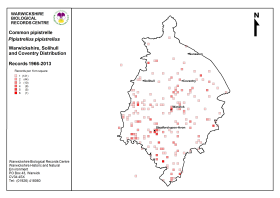
Distribution map for Common Pipistrelle bats in Warwickshire. (Click for a full sized image)
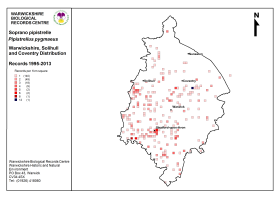
Distribution map for Soprano Pipistrelle bats in Warwickshire. (Click for a full sized image)
The Pipistrelle is Britain's smallest bat and our most common species, especially
in towns. It is found throughout the UK, including the Isle of Man.
It is also abundant and widespread in the rest of Europe.
The Pipistrelle
has probably declined as a result of modern agricultural practices. Its reliance
on buildings makes it vulnerable to renovation work, exclusion and toxic
remedial timber treatment chemicals.
Only recently have scientists recognised that two separate species have been
confused under this one name. The two species were originally identified by
differences in their echolocation calls and later confirmed by DNA studies.
Researchers are now busy working to identify any differences in the ecology and
behaviour of the two species.
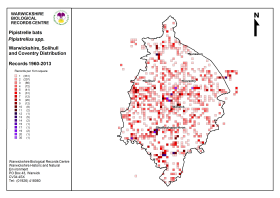
Distribution map for all species of Pipistrelle bats in Warwickshire. (Click for a full sized image)
The names given to the two different species are Common Pipistrelle (Pipistrellus
pipistrellus) and Soprano Pipistrelle (Pipistrellus pygmaeus). There
is also a third species of Pipistrelle resident in the UK, the
Nathusius' Pipistrelle (Pipistrellus
nathusii).
 In
a 2001 study of the European distribution of the two types it was found
that the ranges of both species largely overlap (with the exception of
Sweden, where only the Common Pipistrelle was found). It is thought
that the Soprano Pipistrelle may be a specialist around riparian
(waterside) habitats with the Common Pipistrelle being a generalist
feeder. Although both species occur together there is thought to be no
hybridisation (cross-breeding).
In
a 2001 study of the European distribution of the two types it was found
that the ranges of both species largely overlap (with the exception of
Sweden, where only the Common Pipistrelle was found). It is thought
that the Soprano Pipistrelle may be a specialist around riparian
(waterside) habitats with the Common Pipistrelle being a generalist
feeder. Although both species occur together there is thought to be no
hybridisation (cross-breeding).
The Soprano Pipistrelle (shown in the top of the picture) has a
non-contrasting brown face that merges more into the fur colour. It has an
'open' expression due to the more exposed appearance of the eyes and the fur is
far more of one colour. It also, allegedly, has a distinctive 'perfume'.
The Common Pipistrelle (shown at the bottom of the picture) usually has a jet
black face mask, black ears and black wing membrane. Its fur is at least
two-tone (black rooted with brown outer which shows up best when the fur is
parted).
flight & ultrasound
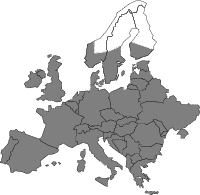 Their flight appears fast and jerky as they dodge about pursuing small
insects, which are caught and eaten in flight. A single Pipistrelle may
consume up to 3,000 insects in a night. Like other small species of bat
they tend to follow linear features of the landscape on their commute
from their roost to feeding areas, but they do periodically pause along
the way to feed. Typically, they fly at about head height (2m) but they
can be found feeding higher in the tree canopy earlier in the evening
and come down lower as the temperature drops. If they need to cross open
spaces they will often fly faster and increase their call rate. They
have been observed to glide for short distances.
Their flight appears fast and jerky as they dodge about pursuing small
insects, which are caught and eaten in flight. A single Pipistrelle may
consume up to 3,000 insects in a night. Like other small species of bat
they tend to follow linear features of the landscape on their commute
from their roost to feeding areas, but they do periodically pause along
the way to feed. Typically, they fly at about head height (2m) but they
can be found feeding higher in the tree canopy earlier in the evening
and come down lower as the temperature drops. If they need to cross open
spaces they will often fly faster and increase their call rate. They
have been observed to glide for short distances.

The ultrasound calls range from 40 to 60kHz. The peak of the Common Pipistrelle's
call is about 45kHz and that of the Soprano about 55kHz. On a heterodyne
bat detector a series of clicks turns
into 'wetter' slaps towards the bottom of the frequency range. To identify
the species of Pipistrelle use headphones and, without looking at the
dial, quickly rotate the frequency dial of the bat detector up and down
between 37 and 60 kHz until the pitch of the 'wet slap' is at its lowest.
(You are looking for the lowest pitch of the sound not its loudness).
If the lowest point is below 48 kHz it is most likely to be a "45"
or Common Pipistrelle. If it is above 52 kHz then the bat is probably
a "55" or Soprano Pipistrelle. If the lowest point appears to
be between 49 and 51 kHz then it will not be possible to assign the bat
to either species. If you find the deepest note is heard below 40 kHz
then it may be a Nathusius' Pipistrelle.
Pipistrelles make their most distinctive sounds when flying in open spaces,
so try and stand in the most open place where bats are flying.
Their
'social' calls are emitted between 20 to 30 kHz and are heard as 'chonks';
these calls can be heard by some adults and children.
 Pipistrelle recorded on a Heterodyne bat detector.
Pipistrelle recorded on a Heterodyne bat detector.
 Pipistrelle bat call recorded on a Time Expansion bat detector.
Pipistrelle bat call recorded on a Time Expansion bat detector.
The intensity of their call is staggering. Just 10cm in front of them
levels can reach 120 decibels which is the equivalent of holding a smoke
alarm to your ear!
breeding
Mating occurs during autumn at well established mating roosts and occasionally
in spring. Maternity colonies consist almost exclusively of female bats
and are occupied between May and August but sometimes into September.
Females give birth to their single young which weigh in at about 1 gram
(occasionally twins - especially in Scotland) from early June to mid-July,
though births as late as August have been recorded.
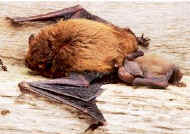 The
young are fed solely on their mother's milk and females with young to
suckle may make several feeding trips during the night, leaving the young
inside the roost in a group or crèche. Within three weeks the young make
their first flights having more than tripled their birth weight to around
3.5 grammes, and by six weeks they can forage for themselves. They reach
their adult weight of about 4 grammes in 50-60 days. Most colonies start
to disperse soon after the young are weaned.
The
young are fed solely on their mother's milk and females with young to
suckle may make several feeding trips during the night, leaving the young
inside the roost in a group or crèche. Within three weeks the young make
their first flights having more than tripled their birth weight to around
3.5 grammes, and by six weeks they can forage for themselves. They reach
their adult weight of about 4 grammes in 50-60 days. Most colonies start
to disperse soon after the young are weaned.
Pipistrelles may remain at a single site during this time, but more often,
particularly in newer housing, they more irregularly between several sites
within a small area. As a consequence numbers at any one site can fluctuate
markedly throughout the summer.
Females can reach maturity by their first autumn but most males will
not reach sexual maturity until the following summer.
The soprano Pipistrelle (55kHz) tends to form larger roosts.
summer roosts
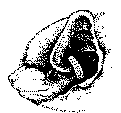 Buildings
are the most favoured roost sites and more than half of known roosts are
in buildings less than 30 years old. Pipistrelles prefer to roost in very
confined spaces around the outside of the building; typical sites being
behind hanging tiles, weather boarding, soffit and barge or eaves boarding,
between roofing felt and roof tiles or in cavity walls. They rarely enter
roof spaces except in the more stable, well-established large colonies
found particularly in older buildings.
Buildings
are the most favoured roost sites and more than half of known roosts are
in buildings less than 30 years old. Pipistrelles prefer to roost in very
confined spaces around the outside of the building; typical sites being
behind hanging tiles, weather boarding, soffit and barge or eaves boarding,
between roofing felt and roof tiles or in cavity walls. They rarely enter
roof spaces except in the more stable, well-established large colonies
found particularly in older buildings.
There may be a slight smudge around a well used access hole, otherwise
the only evidence of bats is the presence of droppings beneath the favoured
entrance, on windows, windowsills and walls. They are also found roosting
in tree holes and crevices, behind ivy and in bat boxes. The access hole
can be a slit as little as half an inch wide.
Pipistrelles can be active within the roost during the day, especially
if young are present and the roost gets very hot. They may also be noisy
as the time for emergence approaches. They usually start to emerge from
the roost about 20 minutes after sunset. Large numbers circling around
the roost entrance at dawn (known as 'swarming behaviour') can be a spectacular
sight.
winter roosts
Despite
being by far the most frequently recorded species in summer, few Pipistrelles
are found in winter. Most winter records are of isolated individuals or
small groups in crevices in buildings and trees so their presence often
goes undetected. They often roost in fairly exposed situations to take
advantage of warmer weather to feed. They are only very rarely found roosting
in caves or tunnels.
Extreme cold weather forces them to change roost and at such times they
often appear in houses. Individuals in poor condition are found in unlikely
places such as hanging in the open on a bare exposed wall.
"External characters discriminating sibling species of European
Pipistrelles"
From Myotis Vol. 37 1999 (Haussler, Nagel, Brown and Arnold)
|
| |
Pipistrellus pipistrellus
(42-47 kHz)
Common Pipistrelle |
Pipistrellus pygmaeus
(52-60 kHz)
Soprano Pipistrelle |
| Forearm Length |
31.03 ± 0.84 mm (Male)
31.77 ± 0.87 mm (Female) |
29.95 ± 0.66 mm (Male)
30.60 ± 0.83 mm (Female) |
| Length of 5th Finger |
37.73 ± 1.03 mm (Male)
38.79 ± 1.33 mm (Female) |
36.19 ± 0.83 mm (Male)
37.23 ± 1.02 mm (Female) |
Third Finger:
2nd to 3rd Phalange ratio |
2nd phalange longer (by 1-2+ mm) |
2nd and 3rd phalange equal or,
(rarely) 2nd phalange slightly longer (<1 mm) |
| Muzzle |
longer, gradually narrowing |
short, in dorsal view of equal width at the proximal
two thirds of the length, then converging |
| Nose |
width about 3.3 mm without internarial ridge |
width about 3.1 mm with internarial ridge |
| Auricles |
length of inner margin 8-9 mm
(from deepest point to tip) |
length of inner margin 7-8 mm
(from deepest point to tip) |
| Wing Membrane |
Hair cover of uropatagium sparse and not reaching far
distally
Plagiopatagium with faint white border in some individuals
|
Uropatagium densely covered with hair over proximal
third
Plagiopatagium with clear white border
Pale stains on uropatagial margins
|
| Pelage |
Dense, not as smooth as pygmaeus |
Very dense and silky |
| Colouration |
Back dark brown to rusty
Almost generally dark faces with no conspicuous pale areas |
Back olive brown
Belly yellowish grey
Pale bald areas on face Juveniles more uniform in colour |
| Penis |
Full adults: dark grey to greyish brown, glans penis
with pale median stripe
Juveniles: grey with pale median stripe
|
Full adults: orange colouration, glans penis without
pale median stripe
Juveniles: greyish with no median stripe
|
general characteristics
| Description |
|
| Head and Body Length |
35 - 45 mm |
| Forearm Length |
28 - 35 mm |
| Wingspan |
190 - 250 mm |
| Weight |
3 - 8 g (about 10 paper clips!) |
| Colour |
Medium to Dark Brown. |
|
|
| |
|
| Life Cycle |
|
| Mating Period |
Autumn |
| Maternity Colonies |
Established late spring.
Young: 1 (occasionally twins) born early June to mid-July, weaned
at 6 weeks. |
| Colony Size |
25 to lower 100's (up to 1,000 plus) |
| Longevity |
Up to 16 years. |
| UK Status |
Not threatened. |
|
|
| |
|
| Habitat and Food |
|
| Summer Roosts |
Buildings and trees. |
| Winter Roosts |
Buildings. |
| Feeding Habitat |
Over water, marshes, in open woodland, woodland edges,
farmland, hedgerows, suburban gardens and urban areas. |
| Food |
Midges, caddisflies, mosquitoes, mayflies, lacewings,
small moths.

|
further reading
"A Guide to the identification of Pipistrelle bats" by the Vincent
Wildlife Trust (
pdf,
331Kb).
Intermittent Gliding Flight in the Pipistrelle
Bat" Adrian L. R. Thomas, Gareth Jones, Jeremy M. V. Rayner And Patricia M.
Hughes J. exp. Biol. 149, 407-416 (1990) (pdf
546Kb)
Dietz C, Schunger I, Nill D, Siemers BM and Ivanova T: First record of
Pipistrellus pygmaeus (Leach, 1825) (Chiroptera: Vespertilionidae)
for Bulgaria. Historia naturalis bulgarica, 14: 117-121 (2002).